595ITC CSU: Biometrics Authentication Security and Privacy Report
VerifiedAdded on 2023/03/17
|15
|4450
|60
Report
AI Summary
This report delves into the realm of biometrics authentication, examining its security and privacy implications. It begins with an overview of biometric systems, detailing various applications such as law enforcement, border control, healthcare, airport security, time and attendance, and banking. ...
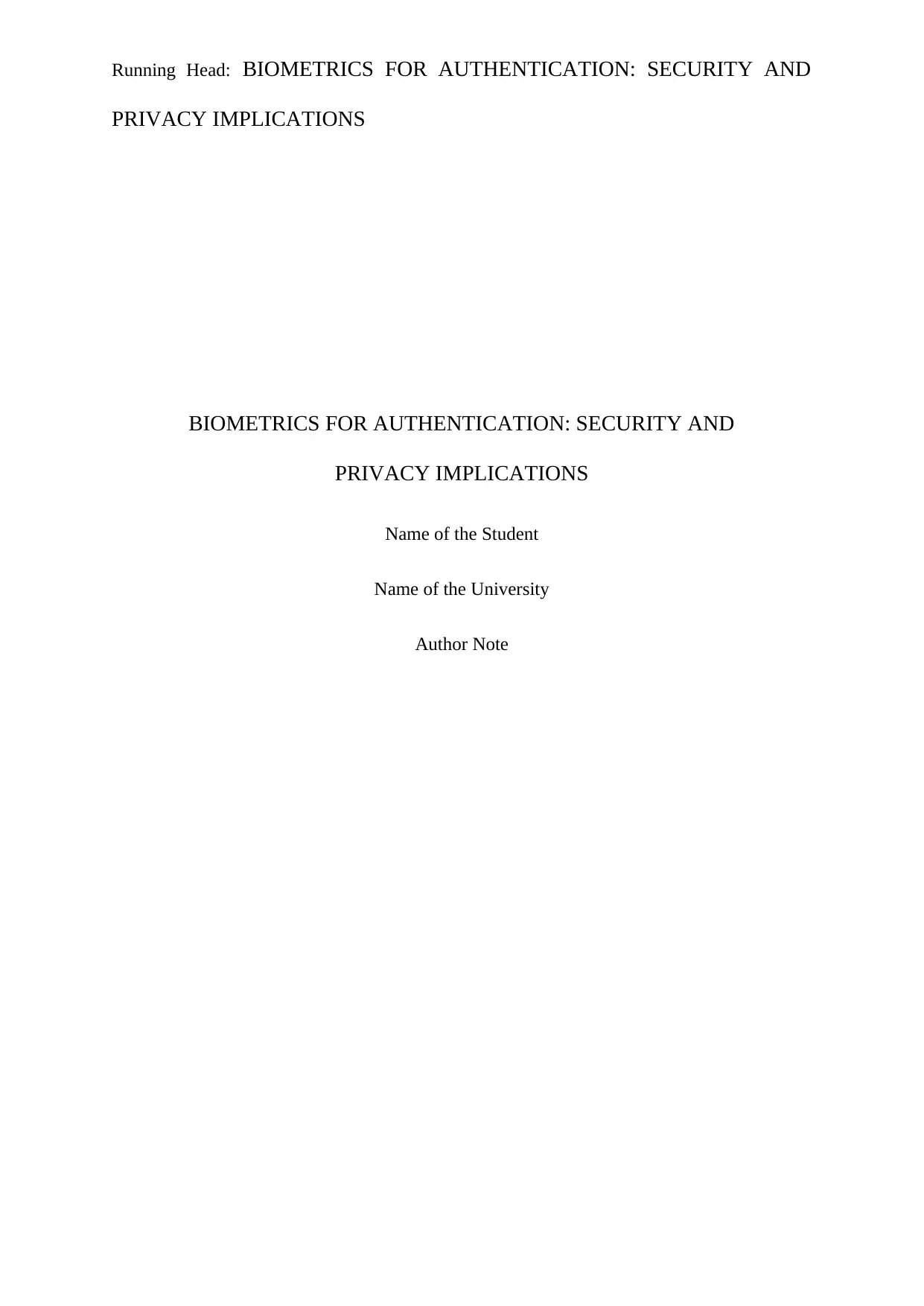
Running Head: BIOMETRICS FOR AUTHENTICATION: SECURITY AND
PRIVACY IMPLICATIONS
BIOMETRICS FOR AUTHENTICATION: SECURITY AND
PRIVACY IMPLICATIONS
Name of the Student
Name of the University
Author Note
PRIVACY IMPLICATIONS
BIOMETRICS FOR AUTHENTICATION: SECURITY AND
PRIVACY IMPLICATIONS
Name of the Student
Name of the University
Author Note
Paraphrase This Document
Need a fresh take? Get an instant paraphrase of this document with our AI Paraphraser
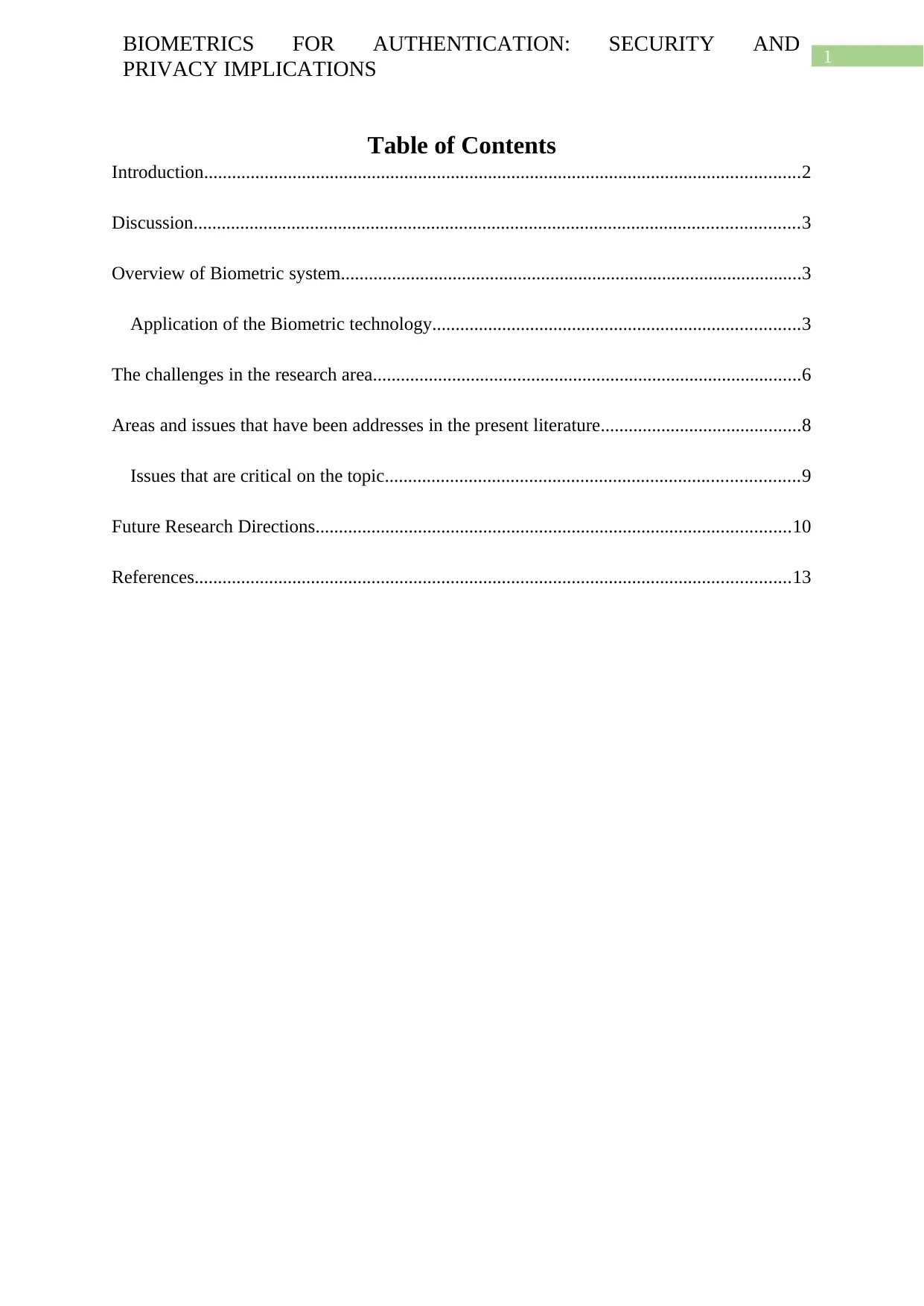
1
BIOMETRICS FOR AUTHENTICATION: SECURITY AND
PRIVACY IMPLICATIONS
Table of Contents
Introduction................................................................................................................................2
Discussion..................................................................................................................................3
Overview of Biometric system...................................................................................................3
Application of the Biometric technology...............................................................................3
The challenges in the research area............................................................................................6
Areas and issues that have been addresses in the present literature...........................................8
Issues that are critical on the topic.........................................................................................9
Future Research Directions......................................................................................................10
References................................................................................................................................13
BIOMETRICS FOR AUTHENTICATION: SECURITY AND
PRIVACY IMPLICATIONS
Table of Contents
Introduction................................................................................................................................2
Discussion..................................................................................................................................3
Overview of Biometric system...................................................................................................3
Application of the Biometric technology...............................................................................3
The challenges in the research area............................................................................................6
Areas and issues that have been addresses in the present literature...........................................8
Issues that are critical on the topic.........................................................................................9
Future Research Directions......................................................................................................10
References................................................................................................................................13
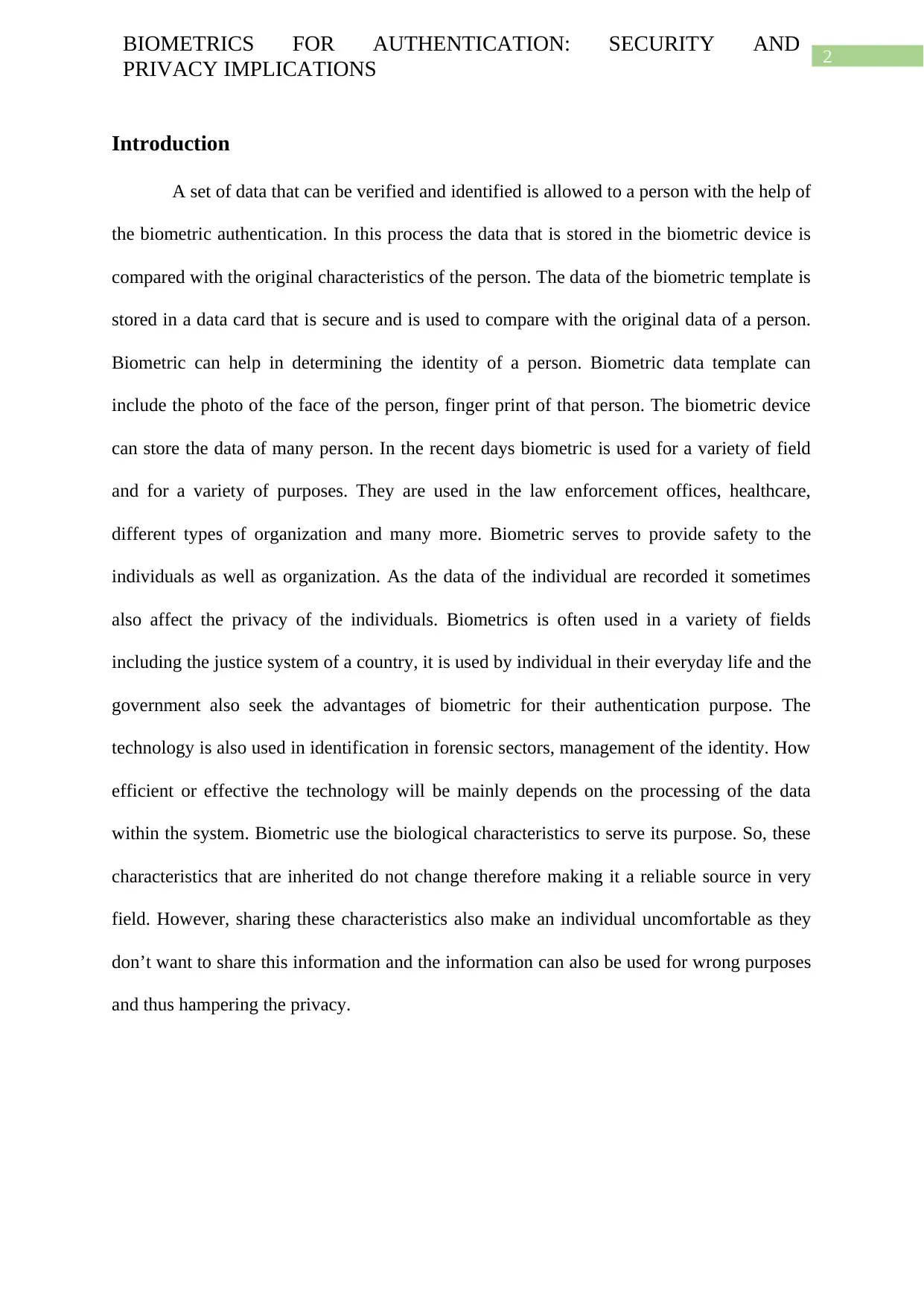
2
BIOMETRICS FOR AUTHENTICATION: SECURITY AND
PRIVACY IMPLICATIONS
Introduction
A set of data that can be verified and identified is allowed to a person with the help of
the biometric authentication. In this process the data that is stored in the biometric device is
compared with the original characteristics of the person. The data of the biometric template is
stored in a data card that is secure and is used to compare with the original data of a person.
Biometric can help in determining the identity of a person. Biometric data template can
include the photo of the face of the person, finger print of that person. The biometric device
can store the data of many person. In the recent days biometric is used for a variety of field
and for a variety of purposes. They are used in the law enforcement offices, healthcare,
different types of organization and many more. Biometric serves to provide safety to the
individuals as well as organization. As the data of the individual are recorded it sometimes
also affect the privacy of the individuals. Biometrics is often used in a variety of fields
including the justice system of a country, it is used by individual in their everyday life and the
government also seek the advantages of biometric for their authentication purpose. The
technology is also used in identification in forensic sectors, management of the identity. How
efficient or effective the technology will be mainly depends on the processing of the data
within the system. Biometric use the biological characteristics to serve its purpose. So, these
characteristics that are inherited do not change therefore making it a reliable source in very
field. However, sharing these characteristics also make an individual uncomfortable as they
don’t want to share this information and the information can also be used for wrong purposes
and thus hampering the privacy.
BIOMETRICS FOR AUTHENTICATION: SECURITY AND
PRIVACY IMPLICATIONS
Introduction
A set of data that can be verified and identified is allowed to a person with the help of
the biometric authentication. In this process the data that is stored in the biometric device is
compared with the original characteristics of the person. The data of the biometric template is
stored in a data card that is secure and is used to compare with the original data of a person.
Biometric can help in determining the identity of a person. Biometric data template can
include the photo of the face of the person, finger print of that person. The biometric device
can store the data of many person. In the recent days biometric is used for a variety of field
and for a variety of purposes. They are used in the law enforcement offices, healthcare,
different types of organization and many more. Biometric serves to provide safety to the
individuals as well as organization. As the data of the individual are recorded it sometimes
also affect the privacy of the individuals. Biometrics is often used in a variety of fields
including the justice system of a country, it is used by individual in their everyday life and the
government also seek the advantages of biometric for their authentication purpose. The
technology is also used in identification in forensic sectors, management of the identity. How
efficient or effective the technology will be mainly depends on the processing of the data
within the system. Biometric use the biological characteristics to serve its purpose. So, these
characteristics that are inherited do not change therefore making it a reliable source in very
field. However, sharing these characteristics also make an individual uncomfortable as they
don’t want to share this information and the information can also be used for wrong purposes
and thus hampering the privacy.
You're viewing a preview
Unlock full access by subscribing today!
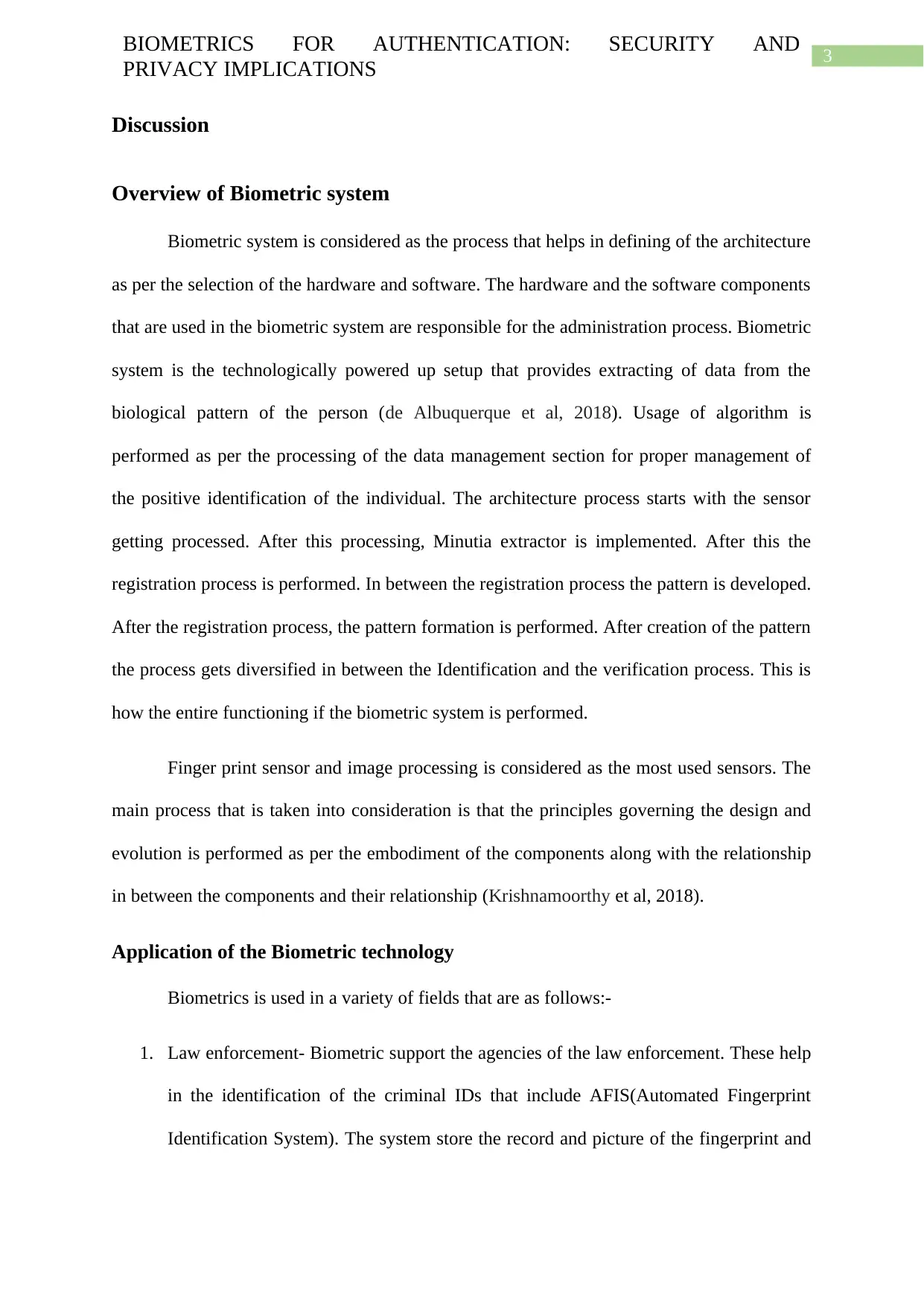
3
BIOMETRICS FOR AUTHENTICATION: SECURITY AND
PRIVACY IMPLICATIONS
Discussion
Overview of Biometric system
Biometric system is considered as the process that helps in defining of the architecture
as per the selection of the hardware and software. The hardware and the software components
that are used in the biometric system are responsible for the administration process. Biometric
system is the technologically powered up setup that provides extracting of data from the
biological pattern of the person (de Albuquerque et al, 2018). Usage of algorithm is
performed as per the processing of the data management section for proper management of
the positive identification of the individual. The architecture process starts with the sensor
getting processed. After this processing, Minutia extractor is implemented. After this the
registration process is performed. In between the registration process the pattern is developed.
After the registration process, the pattern formation is performed. After creation of the pattern
the process gets diversified in between the Identification and the verification process. This is
how the entire functioning if the biometric system is performed.
Finger print sensor and image processing is considered as the most used sensors. The
main process that is taken into consideration is that the principles governing the design and
evolution is performed as per the embodiment of the components along with the relationship
in between the components and their relationship (Krishnamoorthy et al, 2018).
Application of the Biometric technology
Biometrics is used in a variety of fields that are as follows:-
1. Law enforcement- Biometric support the agencies of the law enforcement. These help
in the identification of the criminal IDs that include AFIS(Automated Fingerprint
Identification System). The system store the record and picture of the fingerprint and
BIOMETRICS FOR AUTHENTICATION: SECURITY AND
PRIVACY IMPLICATIONS
Discussion
Overview of Biometric system
Biometric system is considered as the process that helps in defining of the architecture
as per the selection of the hardware and software. The hardware and the software components
that are used in the biometric system are responsible for the administration process. Biometric
system is the technologically powered up setup that provides extracting of data from the
biological pattern of the person (de Albuquerque et al, 2018). Usage of algorithm is
performed as per the processing of the data management section for proper management of
the positive identification of the individual. The architecture process starts with the sensor
getting processed. After this processing, Minutia extractor is implemented. After this the
registration process is performed. In between the registration process the pattern is developed.
After the registration process, the pattern formation is performed. After creation of the pattern
the process gets diversified in between the Identification and the verification process. This is
how the entire functioning if the biometric system is performed.
Finger print sensor and image processing is considered as the most used sensors. The
main process that is taken into consideration is that the principles governing the design and
evolution is performed as per the embodiment of the components along with the relationship
in between the components and their relationship (Krishnamoorthy et al, 2018).
Application of the Biometric technology
Biometrics is used in a variety of fields that are as follows:-
1. Law enforcement- Biometric support the agencies of the law enforcement. These help
in the identification of the criminal IDs that include AFIS(Automated Fingerprint
Identification System). The system store the record and picture of the fingerprint and
Paraphrase This Document
Need a fresh take? Get an instant paraphrase of this document with our AI Paraphraser
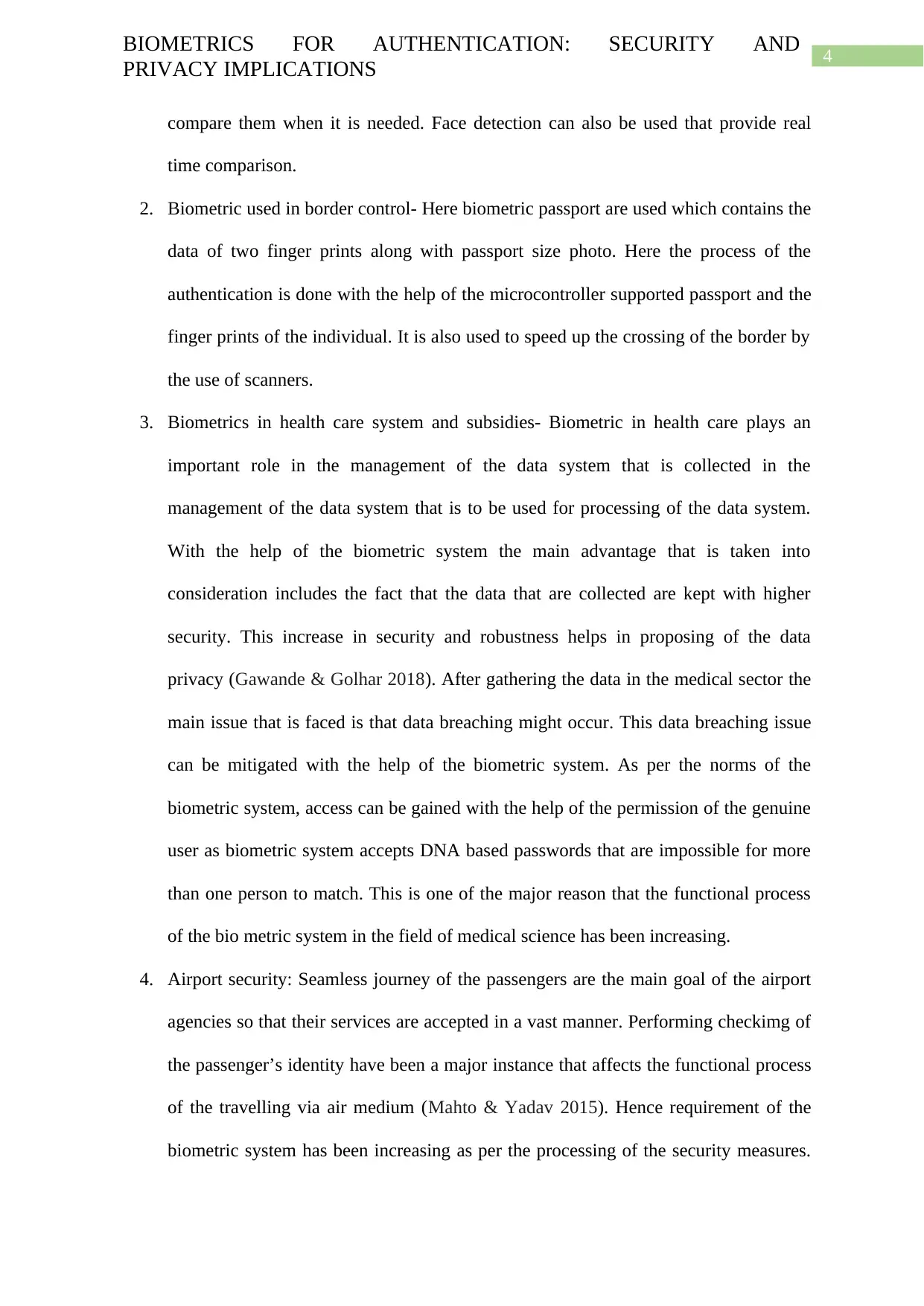
4
BIOMETRICS FOR AUTHENTICATION: SECURITY AND
PRIVACY IMPLICATIONS
compare them when it is needed. Face detection can also be used that provide real
time comparison.
2. Biometric used in border control- Here biometric passport are used which contains the
data of two finger prints along with passport size photo. Here the process of the
authentication is done with the help of the microcontroller supported passport and the
finger prints of the individual. It is also used to speed up the crossing of the border by
the use of scanners.
3. Biometrics in health care system and subsidies- Biometric in health care plays an
important role in the management of the data system that is collected in the
management of the data system that is to be used for processing of the data system.
With the help of the biometric system the main advantage that is taken into
consideration includes the fact that the data that are collected are kept with higher
security. This increase in security and robustness helps in proposing of the data
privacy (Gawande & Golhar 2018). After gathering the data in the medical sector the
main issue that is faced is that data breaching might occur. This data breaching issue
can be mitigated with the help of the biometric system. As per the norms of the
biometric system, access can be gained with the help of the permission of the genuine
user as biometric system accepts DNA based passwords that are impossible for more
than one person to match. This is one of the major reason that the functional process
of the bio metric system in the field of medical science has been increasing.
4. Airport security: Seamless journey of the passengers are the main goal of the airport
agencies so that their services are accepted in a vast manner. Performing checkimg of
the passenger’s identity have been a major instance that affects the functional process
of the travelling via air medium (Mahto & Yadav 2015). Hence requirement of the
biometric system has been increasing as per the processing of the security measures.
BIOMETRICS FOR AUTHENTICATION: SECURITY AND
PRIVACY IMPLICATIONS
compare them when it is needed. Face detection can also be used that provide real
time comparison.
2. Biometric used in border control- Here biometric passport are used which contains the
data of two finger prints along with passport size photo. Here the process of the
authentication is done with the help of the microcontroller supported passport and the
finger prints of the individual. It is also used to speed up the crossing of the border by
the use of scanners.
3. Biometrics in health care system and subsidies- Biometric in health care plays an
important role in the management of the data system that is collected in the
management of the data system that is to be used for processing of the data system.
With the help of the biometric system the main advantage that is taken into
consideration includes the fact that the data that are collected are kept with higher
security. This increase in security and robustness helps in proposing of the data
privacy (Gawande & Golhar 2018). After gathering the data in the medical sector the
main issue that is faced is that data breaching might occur. This data breaching issue
can be mitigated with the help of the biometric system. As per the norms of the
biometric system, access can be gained with the help of the permission of the genuine
user as biometric system accepts DNA based passwords that are impossible for more
than one person to match. This is one of the major reason that the functional process
of the bio metric system in the field of medical science has been increasing.
4. Airport security: Seamless journey of the passengers are the main goal of the airport
agencies so that their services are accepted in a vast manner. Performing checkimg of
the passenger’s identity have been a major instance that affects the functional process
of the travelling via air medium (Mahto & Yadav 2015). Hence requirement of the
biometric system has been increasing as per the processing of the security measures.
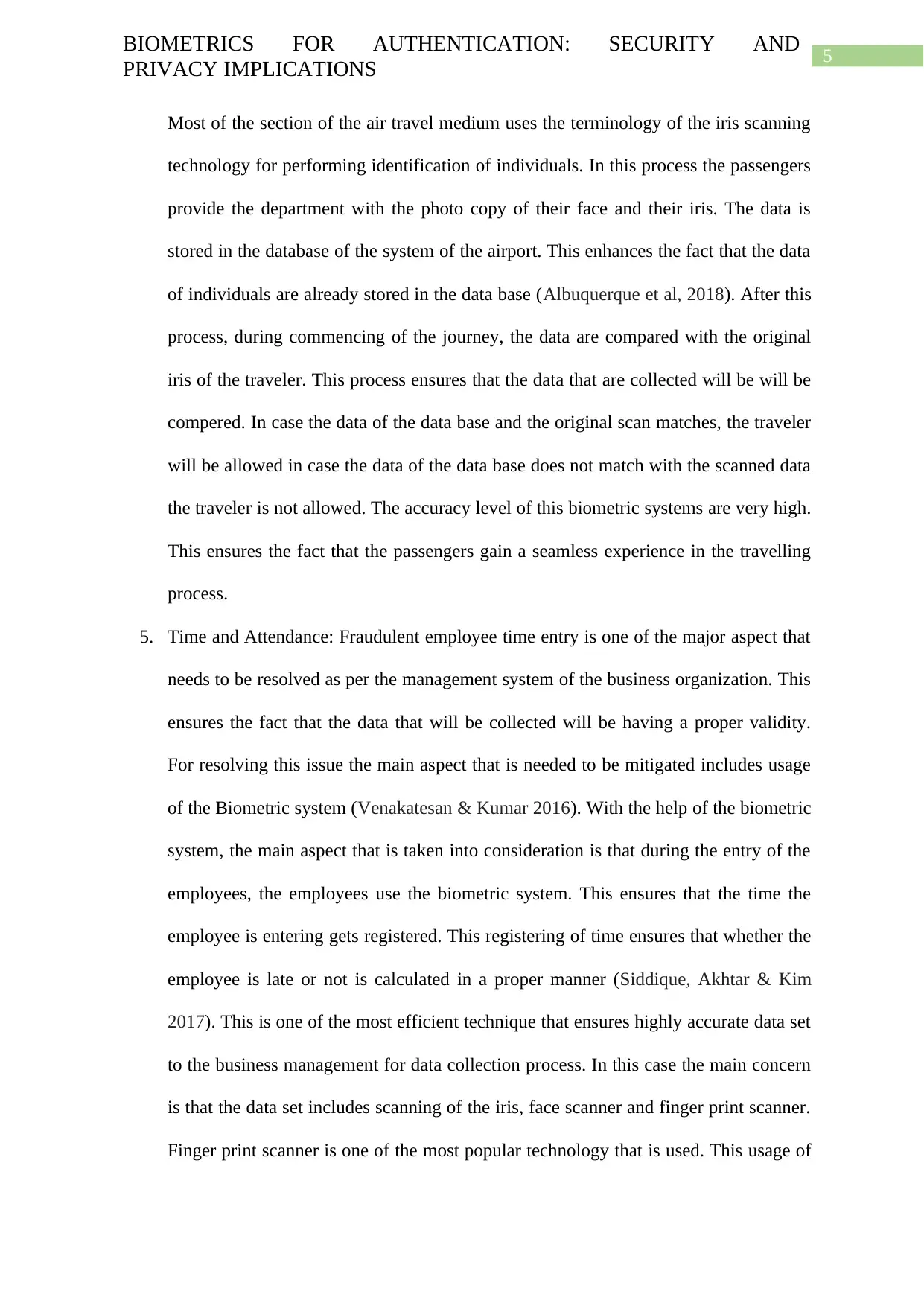
5
BIOMETRICS FOR AUTHENTICATION: SECURITY AND
PRIVACY IMPLICATIONS
Most of the section of the air travel medium uses the terminology of the iris scanning
technology for performing identification of individuals. In this process the passengers
provide the department with the photo copy of their face and their iris. The data is
stored in the database of the system of the airport. This enhances the fact that the data
of individuals are already stored in the data base (Albuquerque et al, 2018). After this
process, during commencing of the journey, the data are compared with the original
iris of the traveler. This process ensures that the data that are collected will be will be
compered. In case the data of the data base and the original scan matches, the traveler
will be allowed in case the data of the data base does not match with the scanned data
the traveler is not allowed. The accuracy level of this biometric systems are very high.
This ensures the fact that the passengers gain a seamless experience in the travelling
process.
5. Time and Attendance: Fraudulent employee time entry is one of the major aspect that
needs to be resolved as per the management system of the business organization. This
ensures the fact that the data that will be collected will be having a proper validity.
For resolving this issue the main aspect that is needed to be mitigated includes usage
of the Biometric system (Venakatesan & Kumar 2016). With the help of the biometric
system, the main aspect that is taken into consideration is that during the entry of the
employees, the employees use the biometric system. This ensures that the time the
employee is entering gets registered. This registering of time ensures that whether the
employee is late or not is calculated in a proper manner (Siddique, Akhtar & Kim
2017). This is one of the most efficient technique that ensures highly accurate data set
to the business management for data collection process. In this case the main concern
is that the data set includes scanning of the iris, face scanner and finger print scanner.
Finger print scanner is one of the most popular technology that is used. This usage of
BIOMETRICS FOR AUTHENTICATION: SECURITY AND
PRIVACY IMPLICATIONS
Most of the section of the air travel medium uses the terminology of the iris scanning
technology for performing identification of individuals. In this process the passengers
provide the department with the photo copy of their face and their iris. The data is
stored in the database of the system of the airport. This enhances the fact that the data
of individuals are already stored in the data base (Albuquerque et al, 2018). After this
process, during commencing of the journey, the data are compared with the original
iris of the traveler. This process ensures that the data that are collected will be will be
compered. In case the data of the data base and the original scan matches, the traveler
will be allowed in case the data of the data base does not match with the scanned data
the traveler is not allowed. The accuracy level of this biometric systems are very high.
This ensures the fact that the passengers gain a seamless experience in the travelling
process.
5. Time and Attendance: Fraudulent employee time entry is one of the major aspect that
needs to be resolved as per the management system of the business organization. This
ensures the fact that the data that will be collected will be having a proper validity.
For resolving this issue the main aspect that is needed to be mitigated includes usage
of the Biometric system (Venakatesan & Kumar 2016). With the help of the biometric
system, the main aspect that is taken into consideration is that during the entry of the
employees, the employees use the biometric system. This ensures that the time the
employee is entering gets registered. This registering of time ensures that whether the
employee is late or not is calculated in a proper manner (Siddique, Akhtar & Kim
2017). This is one of the most efficient technique that ensures highly accurate data set
to the business management for data collection process. In this case the main concern
is that the data set includes scanning of the iris, face scanner and finger print scanner.
Finger print scanner is one of the most popular technology that is used. This usage of
You're viewing a preview
Unlock full access by subscribing today!
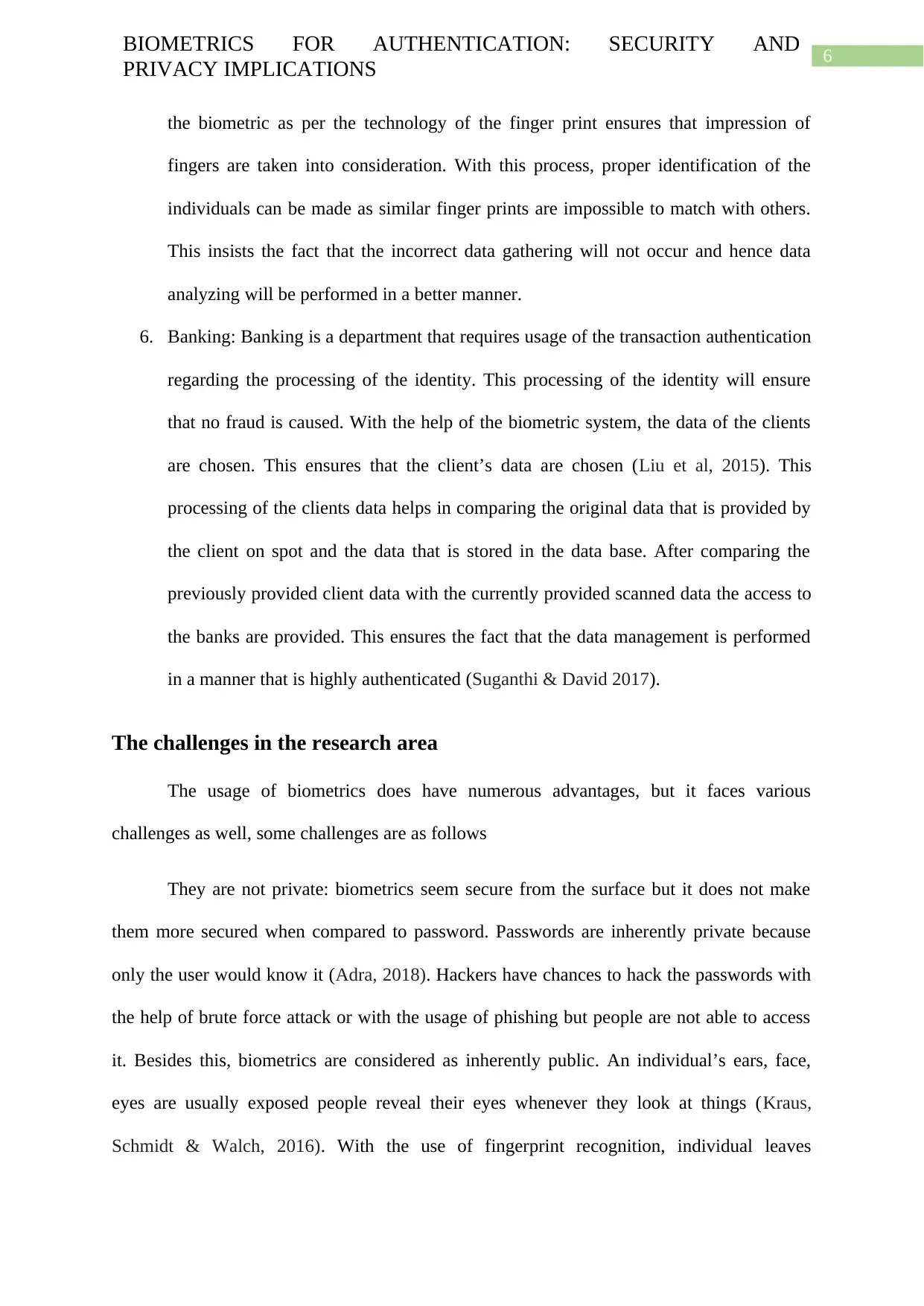
6
BIOMETRICS FOR AUTHENTICATION: SECURITY AND
PRIVACY IMPLICATIONS
the biometric as per the technology of the finger print ensures that impression of
fingers are taken into consideration. With this process, proper identification of the
individuals can be made as similar finger prints are impossible to match with others.
This insists the fact that the incorrect data gathering will not occur and hence data
analyzing will be performed in a better manner.
6. Banking: Banking is a department that requires usage of the transaction authentication
regarding the processing of the identity. This processing of the identity will ensure
that no fraud is caused. With the help of the biometric system, the data of the clients
are chosen. This ensures that the client’s data are chosen (Liu et al, 2015). This
processing of the clients data helps in comparing the original data that is provided by
the client on spot and the data that is stored in the data base. After comparing the
previously provided client data with the currently provided scanned data the access to
the banks are provided. This ensures the fact that the data management is performed
in a manner that is highly authenticated (Suganthi & David 2017).
The challenges in the research area
The usage of biometrics does have numerous advantages, but it faces various
challenges as well, some challenges are as follows
They are not private: biometrics seem secure from the surface but it does not make
them more secured when compared to password. Passwords are inherently private because
only the user would know it (Adra, 2018). Hackers have chances to hack the passwords with
the help of brute force attack or with the usage of phishing but people are not able to access
it. Besides this, biometrics are considered as inherently public. An individual’s ears, face,
eyes are usually exposed people reveal their eyes whenever they look at things (Kraus,
Schmidt & Walch, 2016). With the use of fingerprint recognition, individual leaves
BIOMETRICS FOR AUTHENTICATION: SECURITY AND
PRIVACY IMPLICATIONS
the biometric as per the technology of the finger print ensures that impression of
fingers are taken into consideration. With this process, proper identification of the
individuals can be made as similar finger prints are impossible to match with others.
This insists the fact that the incorrect data gathering will not occur and hence data
analyzing will be performed in a better manner.
6. Banking: Banking is a department that requires usage of the transaction authentication
regarding the processing of the identity. This processing of the identity will ensure
that no fraud is caused. With the help of the biometric system, the data of the clients
are chosen. This ensures that the client’s data are chosen (Liu et al, 2015). This
processing of the clients data helps in comparing the original data that is provided by
the client on spot and the data that is stored in the data base. After comparing the
previously provided client data with the currently provided scanned data the access to
the banks are provided. This ensures the fact that the data management is performed
in a manner that is highly authenticated (Suganthi & David 2017).
The challenges in the research area
The usage of biometrics does have numerous advantages, but it faces various
challenges as well, some challenges are as follows
They are not private: biometrics seem secure from the surface but it does not make
them more secured when compared to password. Passwords are inherently private because
only the user would know it (Adra, 2018). Hackers have chances to hack the passwords with
the help of brute force attack or with the usage of phishing but people are not able to access
it. Besides this, biometrics are considered as inherently public. An individual’s ears, face,
eyes are usually exposed people reveal their eyes whenever they look at things (Kraus,
Schmidt & Walch, 2016). With the use of fingerprint recognition, individual leaves
Paraphrase This Document
Need a fresh take? Get an instant paraphrase of this document with our AI Paraphraser
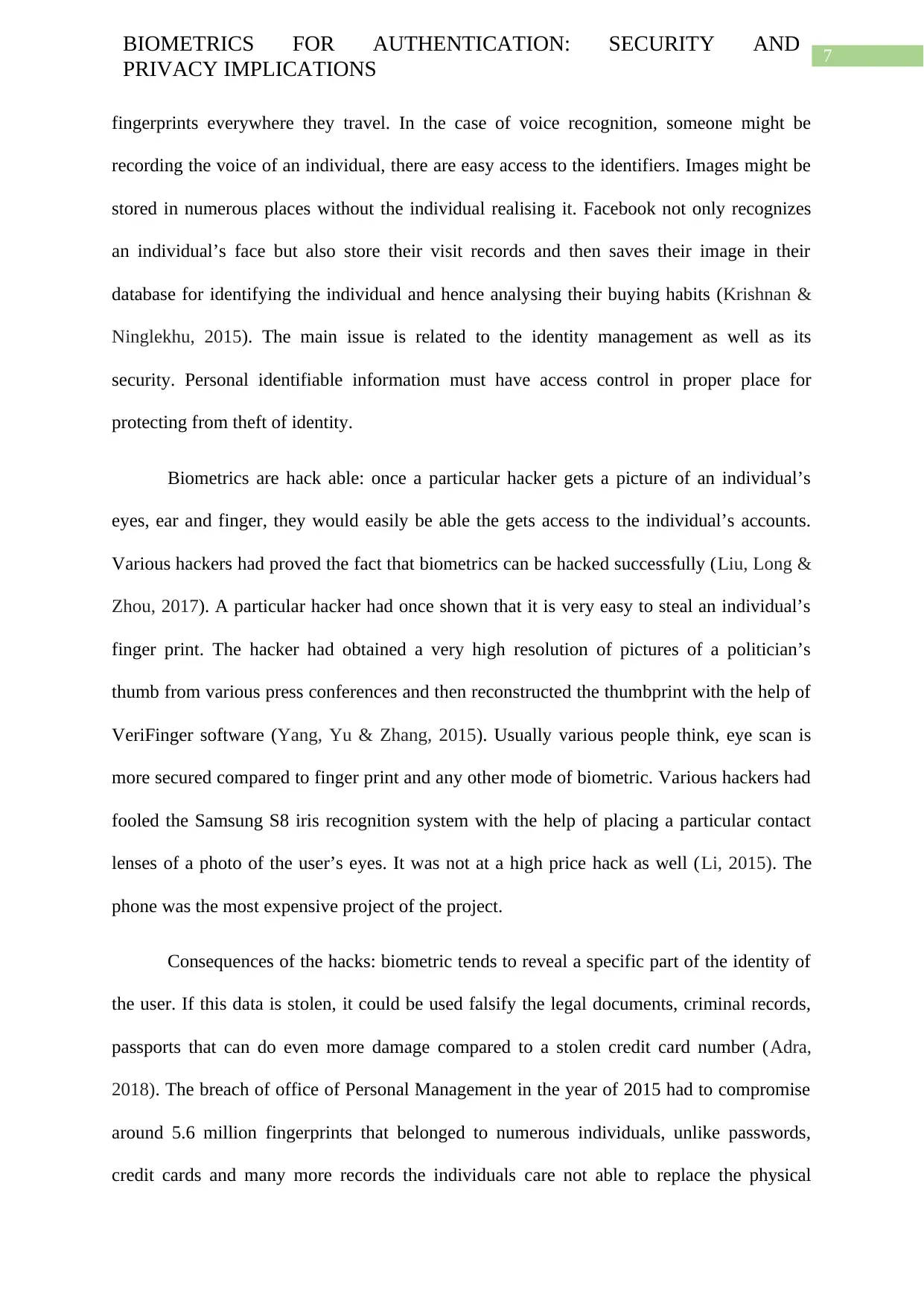
7
BIOMETRICS FOR AUTHENTICATION: SECURITY AND
PRIVACY IMPLICATIONS
fingerprints everywhere they travel. In the case of voice recognition, someone might be
recording the voice of an individual, there are easy access to the identifiers. Images might be
stored in numerous places without the individual realising it. Facebook not only recognizes
an individual’s face but also store their visit records and then saves their image in their
database for identifying the individual and hence analysing their buying habits (Krishnan &
Ninglekhu, 2015). The main issue is related to the identity management as well as its
security. Personal identifiable information must have access control in proper place for
protecting from theft of identity.
Biometrics are hack able: once a particular hacker gets a picture of an individual’s
eyes, ear and finger, they would easily be able the gets access to the individual’s accounts.
Various hackers had proved the fact that biometrics can be hacked successfully (Liu, Long &
Zhou, 2017). A particular hacker had once shown that it is very easy to steal an individual’s
finger print. The hacker had obtained a very high resolution of pictures of a politician’s
thumb from various press conferences and then reconstructed the thumbprint with the help of
VeriFinger software (Yang, Yu & Zhang, 2015). Usually various people think, eye scan is
more secured compared to finger print and any other mode of biometric. Various hackers had
fooled the Samsung S8 iris recognition system with the help of placing a particular contact
lenses of a photo of the user’s eyes. It was not at a high price hack as well (Li, 2015). The
phone was the most expensive project of the project.
Consequences of the hacks: biometric tends to reveal a specific part of the identity of
the user. If this data is stolen, it could be used falsify the legal documents, criminal records,
passports that can do even more damage compared to a stolen credit card number (Adra,
2018). The breach of office of Personal Management in the year of 2015 had to compromise
around 5.6 million fingerprints that belonged to numerous individuals, unlike passwords,
credit cards and many more records the individuals care not able to replace the physical
BIOMETRICS FOR AUTHENTICATION: SECURITY AND
PRIVACY IMPLICATIONS
fingerprints everywhere they travel. In the case of voice recognition, someone might be
recording the voice of an individual, there are easy access to the identifiers. Images might be
stored in numerous places without the individual realising it. Facebook not only recognizes
an individual’s face but also store their visit records and then saves their image in their
database for identifying the individual and hence analysing their buying habits (Krishnan &
Ninglekhu, 2015). The main issue is related to the identity management as well as its
security. Personal identifiable information must have access control in proper place for
protecting from theft of identity.
Biometrics are hack able: once a particular hacker gets a picture of an individual’s
eyes, ear and finger, they would easily be able the gets access to the individual’s accounts.
Various hackers had proved the fact that biometrics can be hacked successfully (Liu, Long &
Zhou, 2017). A particular hacker had once shown that it is very easy to steal an individual’s
finger print. The hacker had obtained a very high resolution of pictures of a politician’s
thumb from various press conferences and then reconstructed the thumbprint with the help of
VeriFinger software (Yang, Yu & Zhang, 2015). Usually various people think, eye scan is
more secured compared to finger print and any other mode of biometric. Various hackers had
fooled the Samsung S8 iris recognition system with the help of placing a particular contact
lenses of a photo of the user’s eyes. It was not at a high price hack as well (Li, 2015). The
phone was the most expensive project of the project.
Consequences of the hacks: biometric tends to reveal a specific part of the identity of
the user. If this data is stolen, it could be used falsify the legal documents, criminal records,
passports that can do even more damage compared to a stolen credit card number (Adra,
2018). The breach of office of Personal Management in the year of 2015 had to compromise
around 5.6 million fingerprints that belonged to numerous individuals, unlike passwords,
credit cards and many more records the individuals care not able to replace the physical
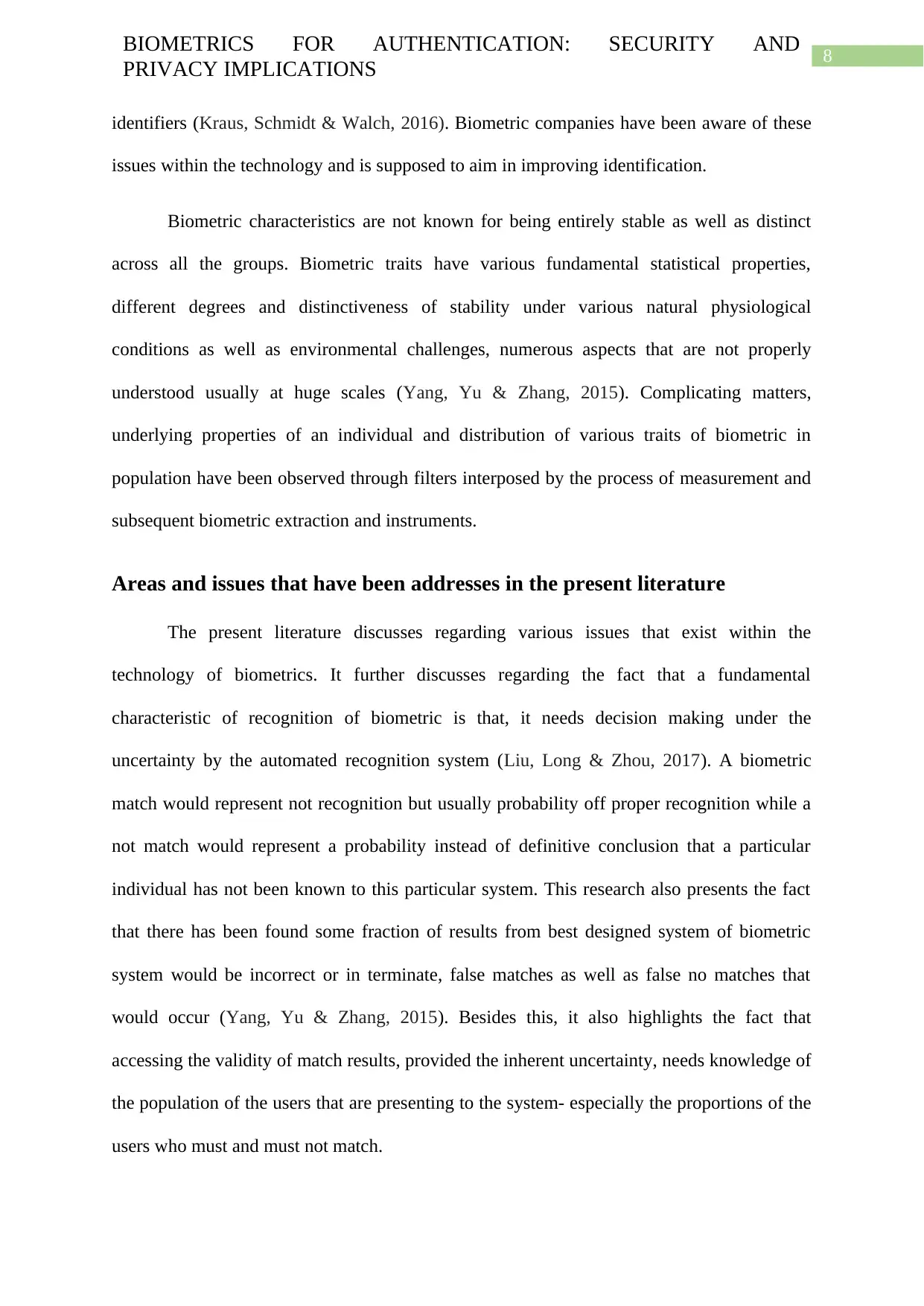
8
BIOMETRICS FOR AUTHENTICATION: SECURITY AND
PRIVACY IMPLICATIONS
identifiers (Kraus, Schmidt & Walch, 2016). Biometric companies have been aware of these
issues within the technology and is supposed to aim in improving identification.
Biometric characteristics are not known for being entirely stable as well as distinct
across all the groups. Biometric traits have various fundamental statistical properties,
different degrees and distinctiveness of stability under various natural physiological
conditions as well as environmental challenges, numerous aspects that are not properly
understood usually at huge scales (Yang, Yu & Zhang, 2015). Complicating matters,
underlying properties of an individual and distribution of various traits of biometric in
population have been observed through filters interposed by the process of measurement and
subsequent biometric extraction and instruments.
Areas and issues that have been addresses in the present literature
The present literature discusses regarding various issues that exist within the
technology of biometrics. It further discusses regarding the fact that a fundamental
characteristic of recognition of biometric is that, it needs decision making under the
uncertainty by the automated recognition system (Liu, Long & Zhou, 2017). A biometric
match would represent not recognition but usually probability off proper recognition while a
not match would represent a probability instead of definitive conclusion that a particular
individual has not been known to this particular system. This research also presents the fact
that there has been found some fraction of results from best designed system of biometric
system would be incorrect or in terminate, false matches as well as false no matches that
would occur (Yang, Yu & Zhang, 2015). Besides this, it also highlights the fact that
accessing the validity of match results, provided the inherent uncertainty, needs knowledge of
the population of the users that are presenting to the system- especially the proportions of the
users who must and must not match.
BIOMETRICS FOR AUTHENTICATION: SECURITY AND
PRIVACY IMPLICATIONS
identifiers (Kraus, Schmidt & Walch, 2016). Biometric companies have been aware of these
issues within the technology and is supposed to aim in improving identification.
Biometric characteristics are not known for being entirely stable as well as distinct
across all the groups. Biometric traits have various fundamental statistical properties,
different degrees and distinctiveness of stability under various natural physiological
conditions as well as environmental challenges, numerous aspects that are not properly
understood usually at huge scales (Yang, Yu & Zhang, 2015). Complicating matters,
underlying properties of an individual and distribution of various traits of biometric in
population have been observed through filters interposed by the process of measurement and
subsequent biometric extraction and instruments.
Areas and issues that have been addresses in the present literature
The present literature discusses regarding various issues that exist within the
technology of biometrics. It further discusses regarding the fact that a fundamental
characteristic of recognition of biometric is that, it needs decision making under the
uncertainty by the automated recognition system (Liu, Long & Zhou, 2017). A biometric
match would represent not recognition but usually probability off proper recognition while a
not match would represent a probability instead of definitive conclusion that a particular
individual has not been known to this particular system. This research also presents the fact
that there has been found some fraction of results from best designed system of biometric
system would be incorrect or in terminate, false matches as well as false no matches that
would occur (Yang, Yu & Zhang, 2015). Besides this, it also highlights the fact that
accessing the validity of match results, provided the inherent uncertainty, needs knowledge of
the population of the users that are presenting to the system- especially the proportions of the
users who must and must not match.
You're viewing a preview
Unlock full access by subscribing today!
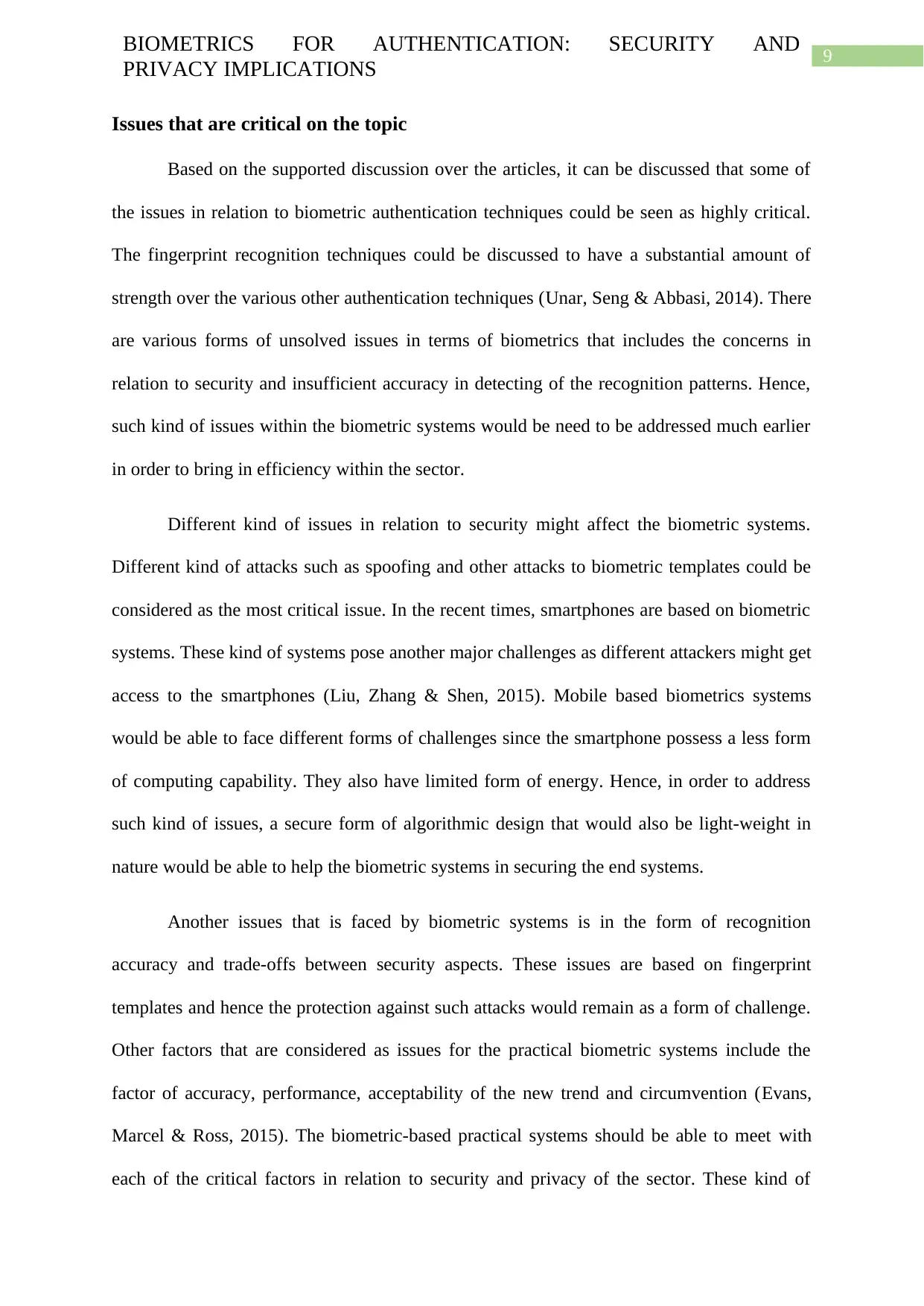
9
BIOMETRICS FOR AUTHENTICATION: SECURITY AND
PRIVACY IMPLICATIONS
Issues that are critical on the topic
Based on the supported discussion over the articles, it can be discussed that some of
the issues in relation to biometric authentication techniques could be seen as highly critical.
The fingerprint recognition techniques could be discussed to have a substantial amount of
strength over the various other authentication techniques (Unar, Seng & Abbasi, 2014). There
are various forms of unsolved issues in terms of biometrics that includes the concerns in
relation to security and insufficient accuracy in detecting of the recognition patterns. Hence,
such kind of issues within the biometric systems would be need to be addressed much earlier
in order to bring in efficiency within the sector.
Different kind of issues in relation to security might affect the biometric systems.
Different kind of attacks such as spoofing and other attacks to biometric templates could be
considered as the most critical issue. In the recent times, smartphones are based on biometric
systems. These kind of systems pose another major challenges as different attackers might get
access to the smartphones (Liu, Zhang & Shen, 2015). Mobile based biometrics systems
would be able to face different forms of challenges since the smartphone possess a less form
of computing capability. They also have limited form of energy. Hence, in order to address
such kind of issues, a secure form of algorithmic design that would also be light-weight in
nature would be able to help the biometric systems in securing the end systems.
Another issues that is faced by biometric systems is in the form of recognition
accuracy and trade-offs between security aspects. These issues are based on fingerprint
templates and hence the protection against such attacks would remain as a form of challenge.
Other factors that are considered as issues for the practical biometric systems include the
factor of accuracy, performance, acceptability of the new trend and circumvention (Evans,
Marcel & Ross, 2015). The biometric-based practical systems should be able to meet with
each of the critical factors in relation to security and privacy of the sector. These kind of
BIOMETRICS FOR AUTHENTICATION: SECURITY AND
PRIVACY IMPLICATIONS
Issues that are critical on the topic
Based on the supported discussion over the articles, it can be discussed that some of
the issues in relation to biometric authentication techniques could be seen as highly critical.
The fingerprint recognition techniques could be discussed to have a substantial amount of
strength over the various other authentication techniques (Unar, Seng & Abbasi, 2014). There
are various forms of unsolved issues in terms of biometrics that includes the concerns in
relation to security and insufficient accuracy in detecting of the recognition patterns. Hence,
such kind of issues within the biometric systems would be need to be addressed much earlier
in order to bring in efficiency within the sector.
Different kind of issues in relation to security might affect the biometric systems.
Different kind of attacks such as spoofing and other attacks to biometric templates could be
considered as the most critical issue. In the recent times, smartphones are based on biometric
systems. These kind of systems pose another major challenges as different attackers might get
access to the smartphones (Liu, Zhang & Shen, 2015). Mobile based biometrics systems
would be able to face different forms of challenges since the smartphone possess a less form
of computing capability. They also have limited form of energy. Hence, in order to address
such kind of issues, a secure form of algorithmic design that would also be light-weight in
nature would be able to help the biometric systems in securing the end systems.
Another issues that is faced by biometric systems is in the form of recognition
accuracy and trade-offs between security aspects. These issues are based on fingerprint
templates and hence the protection against such attacks would remain as a form of challenge.
Other factors that are considered as issues for the practical biometric systems include the
factor of accuracy, performance, acceptability of the new trend and circumvention (Evans,
Marcel & Ross, 2015). The biometric-based practical systems should be able to meet with
each of the critical factors in relation to security and privacy of the sector. These kind of
Paraphrase This Document
Need a fresh take? Get an instant paraphrase of this document with our AI Paraphraser
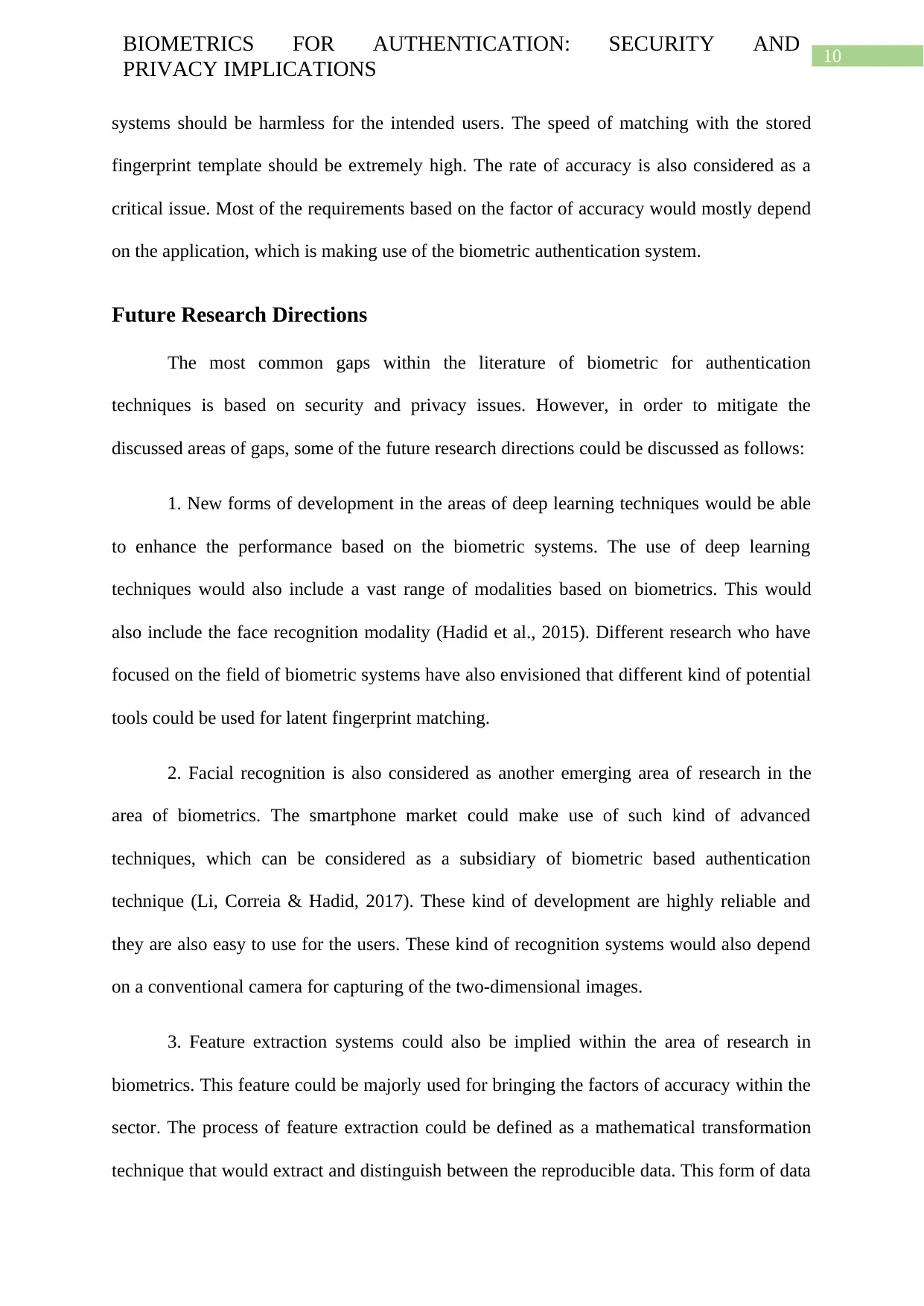
10
BIOMETRICS FOR AUTHENTICATION: SECURITY AND
PRIVACY IMPLICATIONS
systems should be harmless for the intended users. The speed of matching with the stored
fingerprint template should be extremely high. The rate of accuracy is also considered as a
critical issue. Most of the requirements based on the factor of accuracy would mostly depend
on the application, which is making use of the biometric authentication system.
Future Research Directions
The most common gaps within the literature of biometric for authentication
techniques is based on security and privacy issues. However, in order to mitigate the
discussed areas of gaps, some of the future research directions could be discussed as follows:
1. New forms of development in the areas of deep learning techniques would be able
to enhance the performance based on the biometric systems. The use of deep learning
techniques would also include a vast range of modalities based on biometrics. This would
also include the face recognition modality (Hadid et al., 2015). Different research who have
focused on the field of biometric systems have also envisioned that different kind of potential
tools could be used for latent fingerprint matching.
2. Facial recognition is also considered as another emerging area of research in the
area of biometrics. The smartphone market could make use of such kind of advanced
techniques, which can be considered as a subsidiary of biometric based authentication
technique (Li, Correia & Hadid, 2017). These kind of development are highly reliable and
they are also easy to use for the users. These kind of recognition systems would also depend
on a conventional camera for capturing of the two-dimensional images.
3. Feature extraction systems could also be implied within the area of research in
biometrics. This feature could be majorly used for bringing the factors of accuracy within the
sector. The process of feature extraction could be defined as a mathematical transformation
technique that would extract and distinguish between the reproducible data. This form of data
BIOMETRICS FOR AUTHENTICATION: SECURITY AND
PRIVACY IMPLICATIONS
systems should be harmless for the intended users. The speed of matching with the stored
fingerprint template should be extremely high. The rate of accuracy is also considered as a
critical issue. Most of the requirements based on the factor of accuracy would mostly depend
on the application, which is making use of the biometric authentication system.
Future Research Directions
The most common gaps within the literature of biometric for authentication
techniques is based on security and privacy issues. However, in order to mitigate the
discussed areas of gaps, some of the future research directions could be discussed as follows:
1. New forms of development in the areas of deep learning techniques would be able
to enhance the performance based on the biometric systems. The use of deep learning
techniques would also include a vast range of modalities based on biometrics. This would
also include the face recognition modality (Hadid et al., 2015). Different research who have
focused on the field of biometric systems have also envisioned that different kind of potential
tools could be used for latent fingerprint matching.
2. Facial recognition is also considered as another emerging area of research in the
area of biometrics. The smartphone market could make use of such kind of advanced
techniques, which can be considered as a subsidiary of biometric based authentication
technique (Li, Correia & Hadid, 2017). These kind of development are highly reliable and
they are also easy to use for the users. These kind of recognition systems would also depend
on a conventional camera for capturing of the two-dimensional images.
3. Feature extraction systems could also be implied within the area of research in
biometrics. This feature could be majorly used for bringing the factors of accuracy within the
sector. The process of feature extraction could be defined as a mathematical transformation
technique that would extract and distinguish between the reproducible data. This form of data

11
BIOMETRICS FOR AUTHENTICATION: SECURITY AND
PRIVACY IMPLICATIONS
could be defined as a concise representation of the actual information as defined by the
biometric features. A formal template based on biometrics could also be defined as a set of
features that would be compared directly with the different biometric features collected from
other samples (Hasan & Abdul-Kareem, 2014). The enrolment process within the biometric
systems would become much advanced in the near future. Hence the enrolment process
would thus store more than one form of biometric sample. This kind of reference data would
thus be used for comparison for the future identification of individuals and the processes of
verification.
BIOMETRICS FOR AUTHENTICATION: SECURITY AND
PRIVACY IMPLICATIONS
could be defined as a concise representation of the actual information as defined by the
biometric features. A formal template based on biometrics could also be defined as a set of
features that would be compared directly with the different biometric features collected from
other samples (Hasan & Abdul-Kareem, 2014). The enrolment process within the biometric
systems would become much advanced in the near future. Hence the enrolment process
would thus store more than one form of biometric sample. This kind of reference data would
thus be used for comparison for the future identification of individuals and the processes of
verification.
You're viewing a preview
Unlock full access by subscribing today!
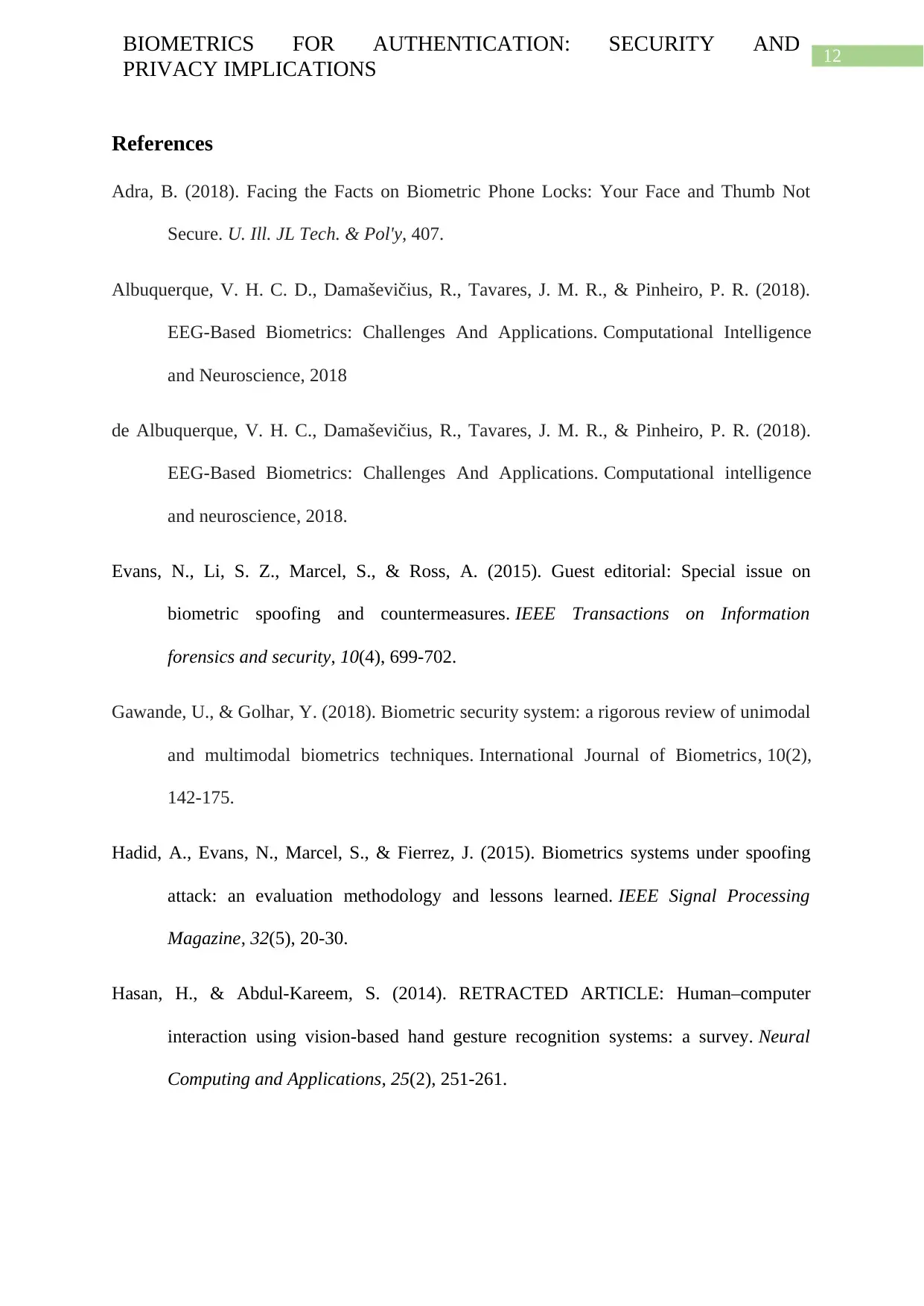
12
BIOMETRICS FOR AUTHENTICATION: SECURITY AND
PRIVACY IMPLICATIONS
References
Adra, B. (2018). Facing the Facts on Biometric Phone Locks: Your Face and Thumb Not
Secure. U. Ill. JL Tech. & Pol'y, 407.
Albuquerque, V. H. C. D., Damaševičius, R., Tavares, J. M. R., & Pinheiro, P. R. (2018).
EEG-Based Biometrics: Challenges And Applications. Computational Intelligence
and Neuroscience, 2018
de Albuquerque, V. H. C., Damaševičius, R., Tavares, J. M. R., & Pinheiro, P. R. (2018).
EEG-Based Biometrics: Challenges And Applications. Computational intelligence
and neuroscience, 2018.
Evans, N., Li, S. Z., Marcel, S., & Ross, A. (2015). Guest editorial: Special issue on
biometric spoofing and countermeasures. IEEE Transactions on Information
forensics and security, 10(4), 699-702.
Gawande, U., & Golhar, Y. (2018). Biometric security system: a rigorous review of unimodal
and multimodal biometrics techniques. International Journal of Biometrics, 10(2),
142-175.
Hadid, A., Evans, N., Marcel, S., & Fierrez, J. (2015). Biometrics systems under spoofing
attack: an evaluation methodology and lessons learned. IEEE Signal Processing
Magazine, 32(5), 20-30.
Hasan, H., & Abdul-Kareem, S. (2014). RETRACTED ARTICLE: Human–computer
interaction using vision-based hand gesture recognition systems: a survey. Neural
Computing and Applications, 25(2), 251-261.
BIOMETRICS FOR AUTHENTICATION: SECURITY AND
PRIVACY IMPLICATIONS
References
Adra, B. (2018). Facing the Facts on Biometric Phone Locks: Your Face and Thumb Not
Secure. U. Ill. JL Tech. & Pol'y, 407.
Albuquerque, V. H. C. D., Damaševičius, R., Tavares, J. M. R., & Pinheiro, P. R. (2018).
EEG-Based Biometrics: Challenges And Applications. Computational Intelligence
and Neuroscience, 2018
de Albuquerque, V. H. C., Damaševičius, R., Tavares, J. M. R., & Pinheiro, P. R. (2018).
EEG-Based Biometrics: Challenges And Applications. Computational intelligence
and neuroscience, 2018.
Evans, N., Li, S. Z., Marcel, S., & Ross, A. (2015). Guest editorial: Special issue on
biometric spoofing and countermeasures. IEEE Transactions on Information
forensics and security, 10(4), 699-702.
Gawande, U., & Golhar, Y. (2018). Biometric security system: a rigorous review of unimodal
and multimodal biometrics techniques. International Journal of Biometrics, 10(2),
142-175.
Hadid, A., Evans, N., Marcel, S., & Fierrez, J. (2015). Biometrics systems under spoofing
attack: an evaluation methodology and lessons learned. IEEE Signal Processing
Magazine, 32(5), 20-30.
Hasan, H., & Abdul-Kareem, S. (2014). RETRACTED ARTICLE: Human–computer
interaction using vision-based hand gesture recognition systems: a survey. Neural
Computing and Applications, 25(2), 251-261.
Paraphrase This Document
Need a fresh take? Get an instant paraphrase of this document with our AI Paraphraser
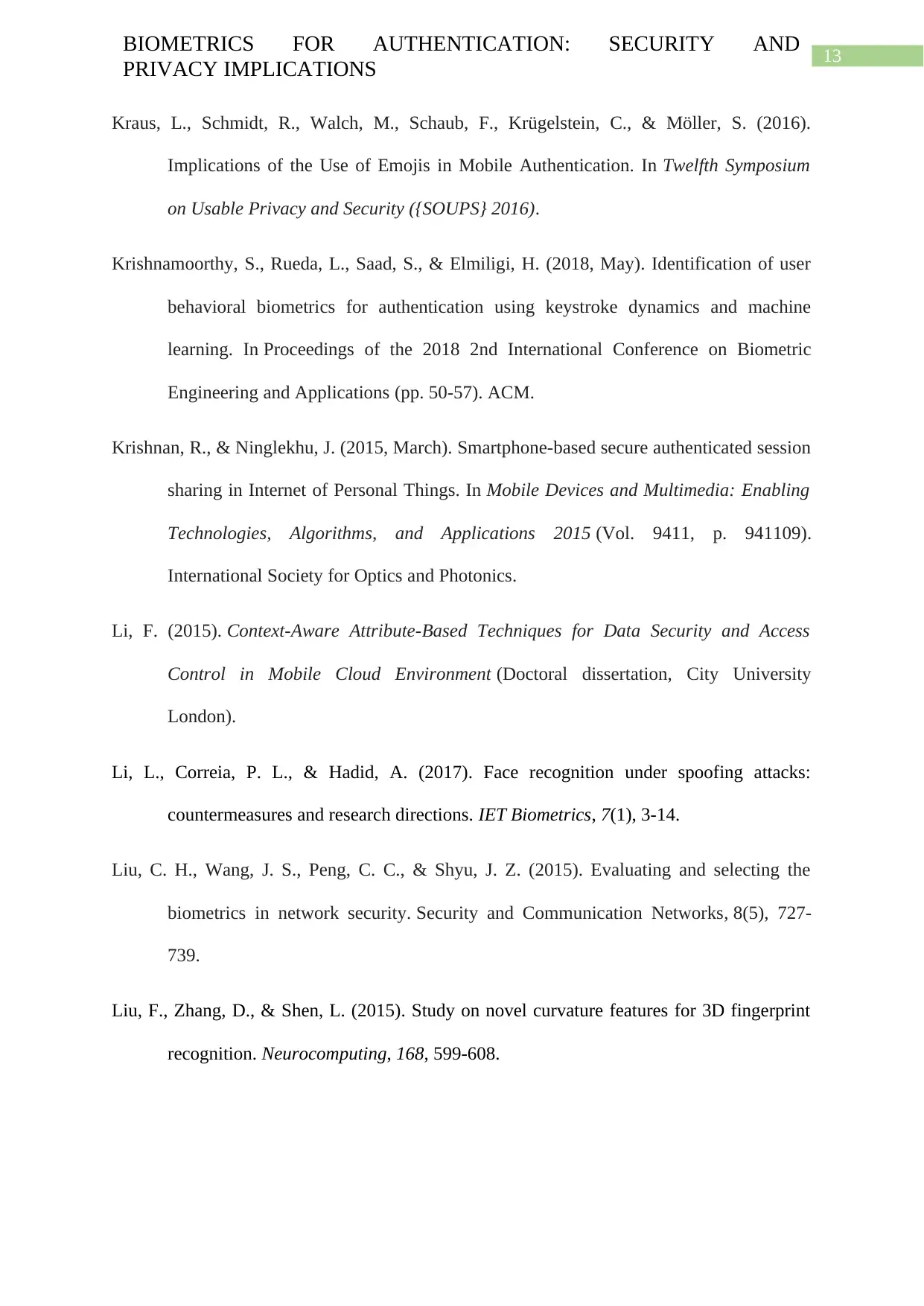
13
BIOMETRICS FOR AUTHENTICATION: SECURITY AND
PRIVACY IMPLICATIONS
Kraus, L., Schmidt, R., Walch, M., Schaub, F., Krügelstein, C., & Möller, S. (2016).
Implications of the Use of Emojis in Mobile Authentication. In Twelfth Symposium
on Usable Privacy and Security ({SOUPS} 2016).
Krishnamoorthy, S., Rueda, L., Saad, S., & Elmiligi, H. (2018, May). Identification of user
behavioral biometrics for authentication using keystroke dynamics and machine
learning. In Proceedings of the 2018 2nd International Conference on Biometric
Engineering and Applications (pp. 50-57). ACM.
Krishnan, R., & Ninglekhu, J. (2015, March). Smartphone-based secure authenticated session
sharing in Internet of Personal Things. In Mobile Devices and Multimedia: Enabling
Technologies, Algorithms, and Applications 2015 (Vol. 9411, p. 941109).
International Society for Optics and Photonics.
Li, F. (2015). Context-Aware Attribute-Based Techniques for Data Security and Access
Control in Mobile Cloud Environment (Doctoral dissertation, City University
London).
Li, L., Correia, P. L., & Hadid, A. (2017). Face recognition under spoofing attacks:
countermeasures and research directions. IET Biometrics, 7(1), 3-14.
Liu, C. H., Wang, J. S., Peng, C. C., & Shyu, J. Z. (2015). Evaluating and selecting the
biometrics in network security. Security and Communication Networks, 8(5), 727-
739.
Liu, F., Zhang, D., & Shen, L. (2015). Study on novel curvature features for 3D fingerprint
recognition. Neurocomputing, 168, 599-608.
BIOMETRICS FOR AUTHENTICATION: SECURITY AND
PRIVACY IMPLICATIONS
Kraus, L., Schmidt, R., Walch, M., Schaub, F., Krügelstein, C., & Möller, S. (2016).
Implications of the Use of Emojis in Mobile Authentication. In Twelfth Symposium
on Usable Privacy and Security ({SOUPS} 2016).
Krishnamoorthy, S., Rueda, L., Saad, S., & Elmiligi, H. (2018, May). Identification of user
behavioral biometrics for authentication using keystroke dynamics and machine
learning. In Proceedings of the 2018 2nd International Conference on Biometric
Engineering and Applications (pp. 50-57). ACM.
Krishnan, R., & Ninglekhu, J. (2015, March). Smartphone-based secure authenticated session
sharing in Internet of Personal Things. In Mobile Devices and Multimedia: Enabling
Technologies, Algorithms, and Applications 2015 (Vol. 9411, p. 941109).
International Society for Optics and Photonics.
Li, F. (2015). Context-Aware Attribute-Based Techniques for Data Security and Access
Control in Mobile Cloud Environment (Doctoral dissertation, City University
London).
Li, L., Correia, P. L., & Hadid, A. (2017). Face recognition under spoofing attacks:
countermeasures and research directions. IET Biometrics, 7(1), 3-14.
Liu, C. H., Wang, J. S., Peng, C. C., & Shyu, J. Z. (2015). Evaluating and selecting the
biometrics in network security. Security and Communication Networks, 8(5), 727-
739.
Liu, F., Zhang, D., & Shen, L. (2015). Study on novel curvature features for 3D fingerprint
recognition. Neurocomputing, 168, 599-608.
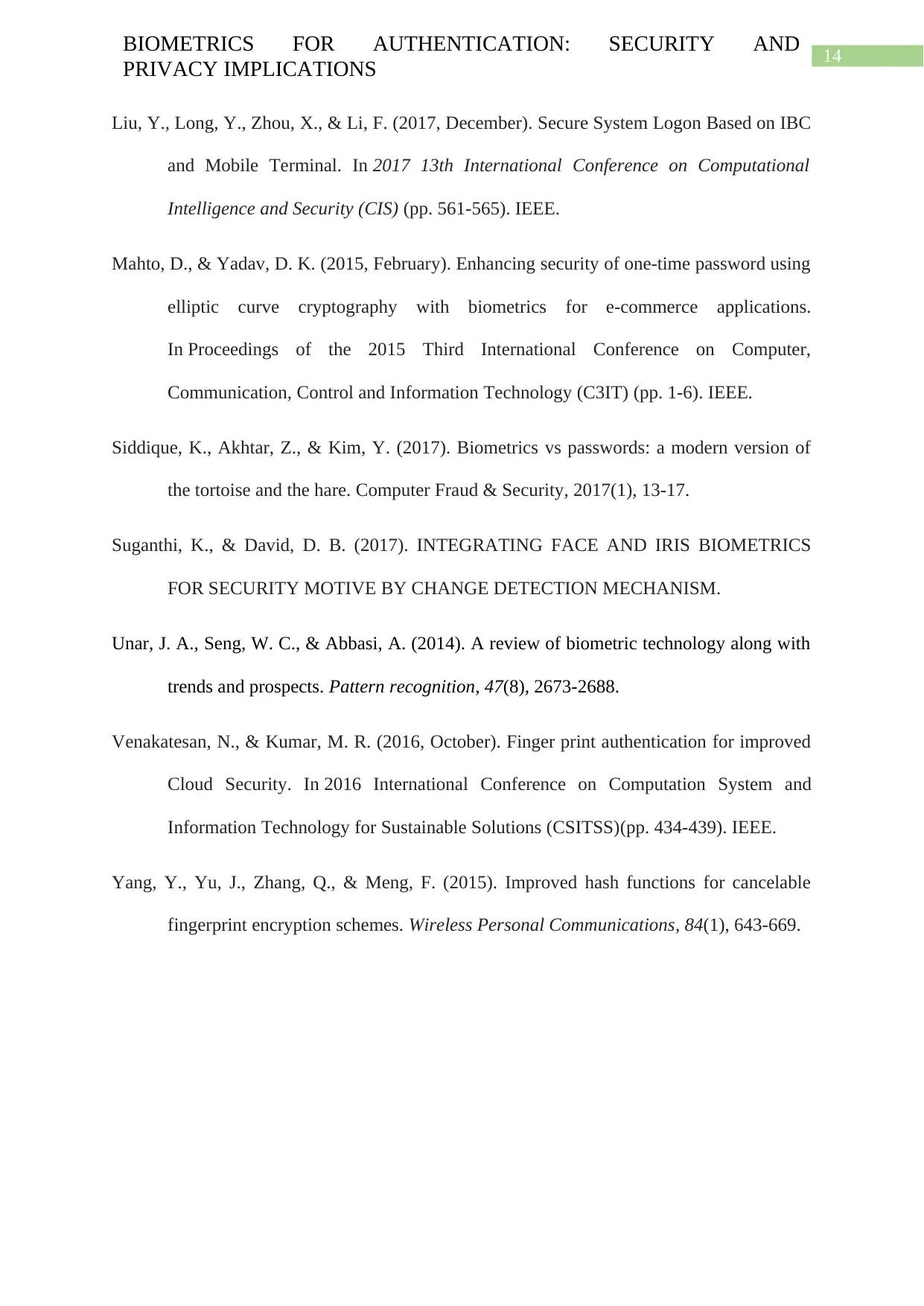
14
BIOMETRICS FOR AUTHENTICATION: SECURITY AND
PRIVACY IMPLICATIONS
Liu, Y., Long, Y., Zhou, X., & Li, F. (2017, December). Secure System Logon Based on IBC
and Mobile Terminal. In 2017 13th International Conference on Computational
Intelligence and Security (CIS) (pp. 561-565). IEEE.
Mahto, D., & Yadav, D. K. (2015, February). Enhancing security of one-time password using
elliptic curve cryptography with biometrics for e-commerce applications.
In Proceedings of the 2015 Third International Conference on Computer,
Communication, Control and Information Technology (C3IT) (pp. 1-6). IEEE.
Siddique, K., Akhtar, Z., & Kim, Y. (2017). Biometrics vs passwords: a modern version of
the tortoise and the hare. Computer Fraud & Security, 2017(1), 13-17.
Suganthi, K., & David, D. B. (2017). INTEGRATING FACE AND IRIS BIOMETRICS
FOR SECURITY MOTIVE BY CHANGE DETECTION MECHANISM.
Unar, J. A., Seng, W. C., & Abbasi, A. (2014). A review of biometric technology along with
trends and prospects. Pattern recognition, 47(8), 2673-2688.
Venakatesan, N., & Kumar, M. R. (2016, October). Finger print authentication for improved
Cloud Security. In 2016 International Conference on Computation System and
Information Technology for Sustainable Solutions (CSITSS)(pp. 434-439). IEEE.
Yang, Y., Yu, J., Zhang, Q., & Meng, F. (2015). Improved hash functions for cancelable
fingerprint encryption schemes. Wireless Personal Communications, 84(1), 643-669.
BIOMETRICS FOR AUTHENTICATION: SECURITY AND
PRIVACY IMPLICATIONS
Liu, Y., Long, Y., Zhou, X., & Li, F. (2017, December). Secure System Logon Based on IBC
and Mobile Terminal. In 2017 13th International Conference on Computational
Intelligence and Security (CIS) (pp. 561-565). IEEE.
Mahto, D., & Yadav, D. K. (2015, February). Enhancing security of one-time password using
elliptic curve cryptography with biometrics for e-commerce applications.
In Proceedings of the 2015 Third International Conference on Computer,
Communication, Control and Information Technology (C3IT) (pp. 1-6). IEEE.
Siddique, K., Akhtar, Z., & Kim, Y. (2017). Biometrics vs passwords: a modern version of
the tortoise and the hare. Computer Fraud & Security, 2017(1), 13-17.
Suganthi, K., & David, D. B. (2017). INTEGRATING FACE AND IRIS BIOMETRICS
FOR SECURITY MOTIVE BY CHANGE DETECTION MECHANISM.
Unar, J. A., Seng, W. C., & Abbasi, A. (2014). A review of biometric technology along with
trends and prospects. Pattern recognition, 47(8), 2673-2688.
Venakatesan, N., & Kumar, M. R. (2016, October). Finger print authentication for improved
Cloud Security. In 2016 International Conference on Computation System and
Information Technology for Sustainable Solutions (CSITSS)(pp. 434-439). IEEE.
Yang, Y., Yu, J., Zhang, Q., & Meng, F. (2015). Improved hash functions for cancelable
fingerprint encryption schemes. Wireless Personal Communications, 84(1), 643-669.
You're viewing a preview
Unlock full access by subscribing today!
1 out of 15
Related Documents
Your All-in-One AI-Powered Toolkit for Academic Success.
+13062052269
info@desklib.com
Available 24*7 on WhatsApp / Email
![[object Object]](/_next/static/media/star-bottom.7253800d.svg)
Unlock your academic potential
© 2024 | Zucol Services PVT LTD | All rights reserved.





